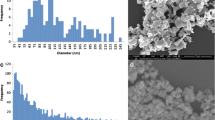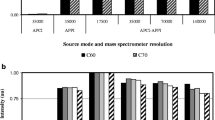Abstract
Engineered nanoparticles (ENP) are increasingly being incorporated into consumer products and reaching the environment at a growing rate. Unfortunately, few analytical techniques are available that allow the detection of ENP in complex environmental matrices. The major limitations with existing techniques are their relatively high detection limits and their inability to distinguish ENP from other chemical forms (e.g. ions, dissolved) or from natural colloids. Of the matrices that are considered to be a priority for method development, ENP are predicted to be found at relatively high concentrations in wastewaters and wastewater biosolids. In this paper, we demonstrate the capability of hydrodynamic chromatography (HDC) coupled to inductively coupled plasma mass spectrometry (ICPMS), in its classical and single particle modes (SP ICPMS), to identify ENP in wastewater influents and effluents. The paper first focuses on the detection of standard silver nanoparticles (Ag NP) and their mixtures, showing that significant dissolution of the Ag NP was likely to occur. For the Ag NP, detection limits of 0.03 μg L−1 were found for the HDC ICPMS whereas 0.1 μg L−1 was determined for the HDC SP ICPMS (based on results for the 80 nm Ag NP). In the second part of the paper, HDC ICPMS and HDC SP ICPMS were performed on some unspiked natural samples (wastewaters, river water). While nanosilver was below detection limits, it was possible to identify some (likely natural) Cu nanoparticles using the developed separation technology.






Similar content being viewed by others
References
Hochella MF. Nanoscience and technology the next revolution in the Earth sciences. Earth Planet Sci Lett. 2002;203(2):593–605. doi:10.1016/s0012-821x(02)00818-x.
Rejeski D, Kuiken T, Pauwels E. Project on Emerging Nanotechnologies. 2013. http;//www.nanotechproject.org/.
Pace HE, Rogers NJ, Jarolimek C, Coleman VA, Gray EP, Higgins CP, et al. Single particle inductively coupled plasma-mass spectrometry: a performance evaluation and method comparison in the determination of nanoparticle size. Environ Sci Technol. 2012;46(22):12272–80. doi:10.1021/es301787d.
Mitrano DM, Lesher EK, Bednar A, Monserud J, Higgins CP, Ranville JF. Detecting nanoparticulate silver using single-particle inductively coupled plasma-mass spectrometry. Environ Toxicol Chem. 2012;31(1):115–21. doi:10.1002/etc.719.
Pycke BFG, Benn TM, Herckes P, Westerhoff P, Halden RU. Strategies for quantifying C-60 fullerenes in environmental and biological samples and implications for studies in environmental health and ecotoxicology. Trac-Trends in Anal Chem. 2011;30(1):44–57. doi:10.1016/j.trac.2010.08.005.
Gottschalk F, Ort C, Scholz RW, Nowack B. Engineered nanomaterials in rivers—exposure scenarios for Switzerland at high spatial and temporal resolution. Environ Pollut. 2011;159(12):3439–45. doi:10.1016/j.envpol.2011.08.023.
Mueller NC, Nowack B. Exposure modeling of engineered nanoparticles in the environment. Environ Sci Technol. 2008;42(12):4447–53. doi:10.1021/es7029637.
Schultz AG, Boyle D, Chamot D, Ong KJ, Wilkinson KJ, McGeer JC, et al. Aquatic toxicity of manufactured nanomaterials: challenges and recommendations for future toxicity testing. Environ Chem. 2014;11(3):207–26. doi:10.1071/en13221.
Mitrano DM, Barber A, Bednar A, Westerhoff P, Higgins CP, Ranville JF. Silver nanoparticle characterization using single particle ICP-MS (SP-ICP-MS) and asymmetrical flow field flow fractionation ICP-MS (AF4-ICP-MS) (vol 27, pg 1131, 2012). J Anal At Spectrom. 2013;28(12):1949.
Tiede K, Boxall ABA, Wang X, Gore D, Tiede D, Baxter M, et al. Application of hydrodynamic chromatography-ICP-MS to investigate the fate of silver nanoparticles in activated sludge. J Anal At Spectrom. 2010;25(7):1149–54. doi:10.1039/b926029c.
von der Kammer F, Ferguson PL, Holden PA, Masion A, Rogers KR, Klaine SJ, et al. Analysis of engineered nanomaterials in complex matrices (environment and biota): general considerations and conceptual case studies. Environ Toxicol Chem. 2012;31(1):32–49. doi:10.1002/etc.723.
Weinberg H, Galyean A, Leopold M. Evaluating engineered nanoparticles in natural waters. Trac-Trends Anal Chem. 2011;30(1):72–83. doi:10.1016/j.trac.2010.09.006.
Proulx K, Wilkinson KJ. Separation, detection and characterisation of engineered nanoparticles in natural waters using hydrodynamic chromatography and multi-method detection (light scattering, analytical ultracentrifugation and single particle ICP-MS). Environ Chem. 2014;11(4):392–401. doi:10.1071/en13232.
Philippe A, Schaumann GE. Evaluation of hydrodynamic chromatography coupled with UV-visible, fluorescence and inductively coupled plasma mass spectrometry detectors for sizing and quantifying colloids in environmental media. Plos One. 2014;9(2). doi:10.1371/journal.pone.0090559.
Striegel AM, Brewer AK. Hydrodynamic chromatography. In: Cooks RG, Yeung ES, editors. Annual Review of Analytical Chemistry, Vol 5. Annual Review of Analytical Chemistry; 2012. p. 15–34.
Degueldre C, Favarger PY. Colloid analysis by single particle inductively coupled plasma-mass spectroscopy: a feasibility study. Colloids Surf A. 2003;217(1–3):137–42. doi:10.1016/s0927-7757(02)00568-x.
Degueldre C, Favarger PY, Wold S. Gold colloid analysis by inductively coupled plasma-mass spectrometry in a single particle mode. Anal Chim Acta. 2006;555(2):263–8. doi:10.1016/j.aca.2005.09.021.
Rakcheev D, Philippe A, Schaumann GE. Hydrodynamic chromatography coupled with single particle-inductively coupled plasma mass spectrometry for investigating nanoparticles agglomerates. Anal Chem. 2013;85(22):10643–7. doi:10.1021/ac4019395.
Laborda F, Jimenez-Lamana J, Bolea E, Castillo JR. Selective identification, characterization and determination of dissolved silver(I) and silver nanoparticles based on single particle detection by inductively coupled plasma mass spectrometry. J Anal At Spectrom. 2011;26(7):1362–71. doi:10.1039/c0ja00098a.
Domingos RF, Baalousha MA, Ju-Nam Y, Reid M, Tufenkji N, Lead JR, Leppard GG, Wilkinson KJ. Characterizing manufactured nanoparticles in the environment - multimethod determination of particle sizes. Environ Sci Technol. 2009;43:7277–84. doi:10.1021/es900249m.
Larkin M. Introduction to light scattering and phase analysis light scattering. Santa Barbara: Wyatt Technology Corporation; 2013.
Hadioui M, Peyrot C, Wilkinson KJ. Improvements to single particle ICPMS by the online coupling of ion exchange resins. Anal Chem. 2014;86(10):4668–74. doi:10.1021/ac5004932.
Pace HE, Rogers NJ, Jarolimek C, Coleman VA, Higgins CP, Ranville JF. Determining transport efficiency for the purpose of counting and sizing nanoparticles via single particle inductively coupled plasma mass spectrometry. Anal Chem. 2011;83(24):9361–9. doi:10.1021/ac201952t.
Franze B, Strenge I, Engelhard C. Single particle inductively coupled plasma mass spectrometry: evaluation of three different pneumatic and piezo-based sample introduction systems for the characterization of silver nanoparticles. J Anal At Spectrom. 2012;27(7):1074–83. doi:10.1039/c2ja00003b.
Cumberland SA, Lead JR. Particle size distributions of silver nanoparticles at environmentally relevant conditions. J Chromatogr A. 2009;1216(52):9099–105. doi:10.1016/j.chroma.2009.07.021.
Meermann B. Field-flow fractionation coupled to ICP-MS: separation at the nanoscale, previous and recent application trends. Anal Bioanal Chem. 2015;407(10):2665–74. doi:10.1007/s00216-014-8416-1.
Meisterjahn B, Neubauer E, Von der Kammer F, Hennecke D, Hofmann T. Asymmetrical flow-field-flow fractionation coupled with inductively coupled plasma mass spectrometry for the analysis of gold nanoparticles in the presence of natural nanoparticles. J Chromatogr A. 2014;1372:204–11. doi:10.1016/j.chroma.2014.10.093.
Hadioui M, Merdzan V, Wilkinson KJ. Detection and characterization of ZnO nanoparticles in surface and waste waters using single particle ICPMS. Environ Sci Technol. 2015;49(10):6141–8. doi:10.1021/acs.est.5b00681.
Acknowledgments
Funding for this work was provided by the Natural Sciences and Engineering Research Council of Canada, the Fonds de Recherche du Québec - Nature et Technologies, the Canadian Water Network and the City of Calgary. Assistance from the Repentigny, Le Gardeur and Montreal WWTP and the groups of Y. Comeau (École Polytechnique) and S. Ghoshal (McGill) was also greatly appreciated.
Author information
Authors and Affiliations
Corresponding author
Ethics declarations
Conflict of Interest
The authors declare having no conflicts of interest related to this publication.
Additional information
Published in the topical collection Single-particle-ICP-MS Advances with guest editors Antonio R. Montoro Bustos and Michael R. Winchester.
Electronic supplementary material
Below is the link to the electronic supplementary material.
ESM 1
(PDF 1007 kb)
Rights and permissions
About this article
Cite this article
Proulx, K., Hadioui, M. & Wilkinson, K.J. Separation, detection and characterization of nanomaterials in municipal wastewaters using hydrodynamic chromatography coupled to ICPMS and single particle ICPMS. Anal Bioanal Chem 408, 5147–5155 (2016). https://doi.org/10.1007/s00216-016-9451-x
Received:
Revised:
Accepted:
Published:
Issue Date:
DOI: https://doi.org/10.1007/s00216-016-9451-x




